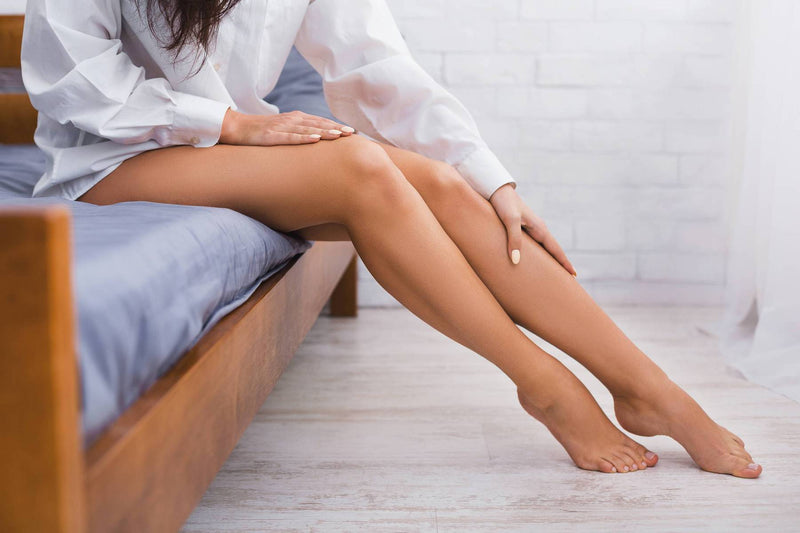Menopause: symptoms and pain
Write the 21/02/2023 by Santarome Bio
After a certain age, a woman's life is marked by what is called menopause. This can cause very annoying or even painful symptoms. Where does menopause come from? How to relieve pain related to menopause? Santarome Bio answers all your questions!
What is menopause?
A natural phenomenon in women, menopause is characterized by the cessation of the functioning of the ovarian cycle, a reduction in the level of female hormones called estrogens and the gradual cessation of periods.
Menopause occurs between the ages of 45 and 55 and varies from one woman to another. Irregular periods, hot flashes and sleep problems are, among other things, some of the various symptoms that occur before and during menopause.

The different symptoms of menopause
Fluctuations in estrogen levels in the body directly cause menopausal symptoms . These symptoms can last 5 months, 10 years or more.
-
Hot flashes
Affected by approximately 75% of women, hot flashes are a feeling of intense heat that are often accompanied by redness, palpitations, heavy sweating and night sweats. These vasomotor symptoms usually begin during perimenopause, the period before menopause, and can last between 30 seconds and 2 minutes. Although they are mostly spontaneous, these symptoms can also be triggered by external things such as following medication, change in temperature, hot and alcoholic drinks or caffeine.
-
Joint and muscle pain
These are typical symptoms faced by 50% of women. Also called “menopausal joint rheumatism”, this pain is characterized by a feeling of stiffness upon waking and mainly affects the shoulders, fingers, hips and knees. Dehydration can also be a source of joint pain.
-
Emotional fragility
Mood swings and irritability are well-known symptoms of perimenopause and menopause. Hormonal changes can lead to depressive episodes, lack of motivation and energy, and detrimental effects on memory and attention.
-
Insomnia
It is also one of the major inconveniences of menopause. Often caused by hot flashes in the middle of the night, it can also occur for no apparent reason.
-
Migraines
Frequent migraines are the result of decreased estrogen levels. This fluctuation affects blood vessels which expand and contract, causing headaches.
-
Urinary disorders
Urinary disorders, or genitourinary syndrome of menopause (GUMS), include infections, irritation and leakage of urine and pain during sexual intercourse caused by vaginal dryness.
Why do we have more pain during menopause?
Estrogens are female hormones produced largely by the ovary and placenta. Essential for the proper functioning of the female body, they perform important functions such as thermoregulation, ovulation and the maintenance of good joint and bone health.
Estrogens have a pain-relieving action on the body and the nervous system and thus help to minimize the pain perception threshold, inflammation and swelling around the joint.
During menopause, the rate of estrogen production decreases, which slows the loss of bone mass, increases the risk of fracture and causes more pain. All this pain that was tolerable before menopause now disrupts daily life.
But do not panic ! Over time, your body adapts to this new hormonal balance and the pain subsides.
Natural solutions to relieve joint pain linked to menopause
Plants are a solution to help joint pain due to their different virtues:
-
Blackcurrant , rich in flavonoids , is ideal for joint pain, rheumatism and feelings of heavy legs.
Harpagophytum relieves joint and tendon pain and has analgesic and anti-rheumatic properties.
Turmuca is an anti-inflammatory, rich in oxidant. It is effective in maintaining good bone and joint health.
Copper contributes to the proper functioning of the body and joints and helps reduce the sensation of pain.
-
Sage regulates estrogen production in the body and reduces hot flashes, joint pain and fatigue
Our My Organic Menopause gummies , composed of Organic Maca, Sage and Lingonberry, help reduce hot flashes and night sweats and provide better comfort during menopause.
Sport stimulates the joints. Moderately practicing physical activity such as cycling, walking, swimming, yoga or low-intensity muscle strengthening promotes blood circulation and prevents pain.
A diet rich in fruits and vegetables will provide your body with all the nutrients it needs to stay in shape. Also choose foods rich in Omega-3 such as fish.
Serotonin levels can also play a role in your pain. Oatmeal, almonds or chocolate contain serotonin precursors and can help boost your happiness hormone!















